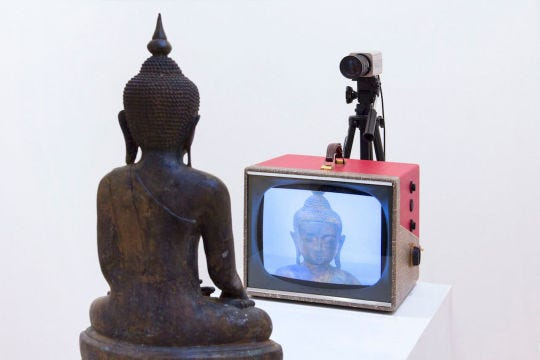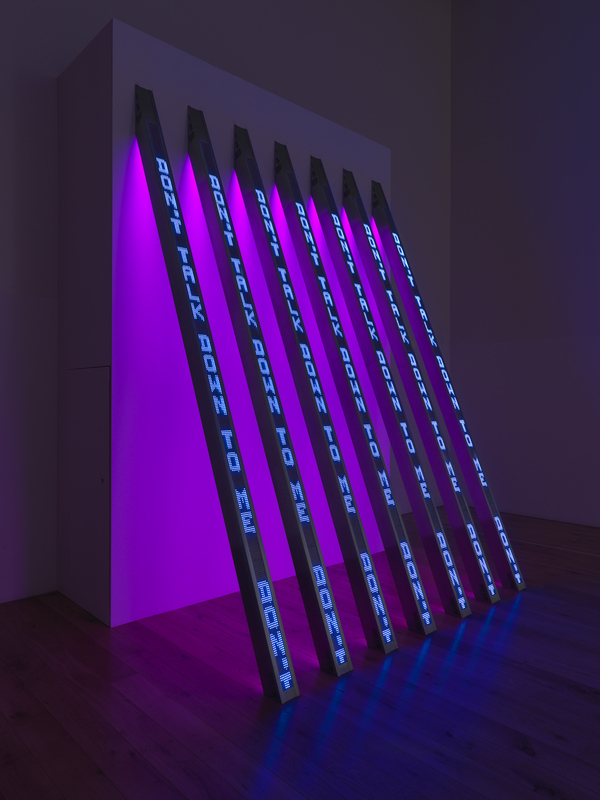The Age of Digital Entertainment: Exploring Post-Modern Art
Introduction
The Age of Digital Entertainment has transformed our daily lives and how we interact with art, media, and technology. This era, beginning in the 1980s and continuing to the present day, is marked by the rise of digital media, the internet, video games, and so much more, which have all become essential parts of our daily lives. Within Post-Modern art, this theme is discussed as artists explore and critique the impact of digital technology on society, culture, and identity. In this week's blog we will explore six works by three different artists during this era discussing the Age of Digital Entertainment. These selected artists are Nam June Paik, Cory Arcangel, and Jenny Holzer.
Nam June Paik
Electronic Superhighway: Continental U.S., Alaska, Hawaii
Discussion
Nam June Paik's Electronic Superhighway: Continental U.S., Alaska, Hawaii is a large multi-video installation that showcases the interconnectedness of the modern world by using technology as an art medium. This work consists of over 300 televisions and lights arranged to form a map of the United States, with each state's identity represented through video clips (Ryan). This work reflects the digital age's influence on the arts by visualizing the way digital media has become a way for communication, connecting people across vast distances.
Aesthetic Reaction
Aesthetically, the neon outlines of the states, combined with the rapid change of television screens, create a sense of overwhelming information, reflecting the digital age's impact on modern day society. The use of televisions as the medium directly ties the artwork to the era of digital entertainment, making it a commentary on how technology has shaped our look on the world (Ryan). The work evokes a sense of both awe and anxiety, bringing people closer while simultaneously flooding them with information.
TV Buddha
Discussion
TV Buddha by Nam June Paik is another exploration of the relationship between technology and art. This installation features a statue of Buddha placed in front of a television displaying a video of the statue itself. The juxtaposition of the ancient figure of Buddha with the modern technology of television creates discussion on the old versus the new.
Aesthetic Reaction
Despite the aesthetic simplicity of TV Buddha, upon further inspection it prompts deep contemplation about the nature and the role of technology in our spiritual lives. The Buddha contrasts with TV images, showing the difference between lasting and temporary things in the digital age. The work evokes a meditative response, encouraging the viewers to reflect on their own relationship with technology and its impact it has on their lives.
Cory Arcangel
Super Mario Clouds
Discussion
Cory Arcangel's Super Mario Clouds is a minimalist reimagining of the original Super Mario Bros. video game. Arcangel hacked the original game cartridge to remove all elements except for the scrolling clouds in the background (Whitney Museum). This work is a critique of digital entertainment, as it strips away the action and interactivity of the game to showcase the often overlooked beauty of simple elements behind the game.
Aesthetic Reaction
Aesthetically, Super Mario Clouds is a serene and almost hypnotic experience. The endless scrolling of the clouds, devoid of any gameplay, creates a sense of calm and maybe nostalgia for some viewers. This work challenges the viewer to reconsider what constitutes art in the digital age, which is the question of "can a hacked video game, devoid of gameplay, still be considered art?" Personally, I that this is indeed art. In fact, to me, much of what makes (most) video games is the art in the game, which many do not take the time to appreciate. Overall, Arcangel's work helps blur the line between entertainment and art, prompting viewers to think critically about the role of digital media in their lives as well as to ponder if video games are art.
Various Self Playing Bowling Games
Discussion
In Various Self Playing Bowling Games, Cory Arcangel takes the concept of video games as art a step further by creating a series of self-playing bowling games. This work features modified video games in which the character is doomed to lose, with the game playing itself indefinitely. This work is a commentary on the nature of gaming and competition, and turns the act of gaming into a form of passive entertainment.
Aesthetic Reaction
Aesthetically, the repetitive nature of the game creates a sense of pointlessness and absurdity, reflecting the sometimes monotonous and unfulfilling aspects of digital entertainment. The work challenges the viewer to reconsider their relationship with video games as well as the concept of winning and losing. By removing the player's control over the game, Arcangel forces the viewer to view the limitations of digital entertainment as a form of escapism.
Jenny Holzer
Blue Purple Tilt
Discussion
Jenny Holzer's Blue Purple Tilt is an LED installation that displays scrolling text in vibrant blue and purple hues. This work is part of Holzer's ongoing exploration of language and its power to influence thought. The use of LED technology ties this work to the digital age, where text is often consumed very rapidly through digital devices.
Aesthetic Reaction
Aesthetically, the scrolling text in Blue Purple Tilt creates a dynamic visual experience, drawing the viewer's attention to the flow of the words. The use of color adds an emotion to the text, strengthening its impact. Holzer's work engages the viewer on both a visual and emotional level, prompting them to reflect on the relationship between language and technology in the digital age.
I Feel You
Discussion
I Feel You is a LED projection installation by Jenny Holzer. This work continues Holzer's exploration of text and technology, with the scrolling words conveying messages of empathy and human connection. In an era where digital communication is heavily depended upon, Holzer's work is a reminder of the importance of real human interaction.
Aesthetic Reaction
Aesthetically, I Feel You is both visually striking and deeply moving. The LED text, with its cool colored glow, contrasts with the warmth of the words it displays, creating a contrast between the work's form and content. This work prompts viewers for introspection, encouraging viewers to consider the role of technology and devices in their relationships and emotional lives.
Conclusion: The Impact of Digital Entertainment on Art
The Age of Digital Entertainment has had quite the impact on the arts, challenging traditional ideas of what is considered art and greatly expanding the boundaries of artistic expression by incorporating technology into art. These three artists are those who have both embraced and critiqued this new era, using technology to create new art forms and engage with audiences in new ways. Their works reflect the complexity of the digital age, showcasing both its potential for creativity but also its limitations. As humanity continues further through this rapidly changing era, these artists help show us to think and engage thoughtfully with this era.
References
Ryan, Tina Rivers. “Nam June Paik, Electronic Superhighway: Continental U.S., Alaska, Hawaii.” Smarthistory, smarthistory.org/nam-june-paik-electronic-superhighway-continental-u-s-alaska-hawaii/. Accessed 1 Aug. 2024.
“Super Mario Clouds.” Cory Arcangel | Super Mario Clouds | Whitney Museum of American Art, whitney.org/collection/works/20588. Accessed 1 Aug. 2024.








Hi Anand,
ReplyDeleteTV Buddha by Nam June Paik is an interesting piece. Is the television projection a reflection of the statue or is the statue a reflection of what the television is projecting? Oddly, it reminds me of Norman Rockwell’s Triple Self Portrait where you see him painting himself while leaning over and looking in a mirror. There are some great introspective pieces. Thank you for sharing!
Hi Anad!
ReplyDeleteI love the pieces you selected and the theme of interconnectedness mixed with the chaotic anxiety that comes with the advancement of interconnectedness through digital mediums! I also love the pieces like TV Buddha and Various Self Playing Bowling Games that highlight the “emptiness” or potential pointlessness of technology (maybe not the technology itself, but the way in which technology can give forth a feeling of pointlessness)! TV Buddha almost feels like a take on modern influencer culture and how social movements now start vs. how they have historically started. There’s also an interesting layer that can be added if one considers some of the messages of Buddhist interpretations like Chen Buddhism, which argues that “people” are a collection of processes rather than “things”! Thank you for sharing these pieces; they are very cool!
-Andy